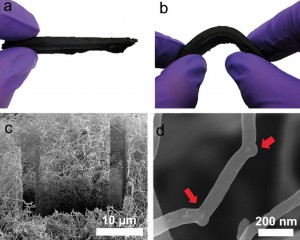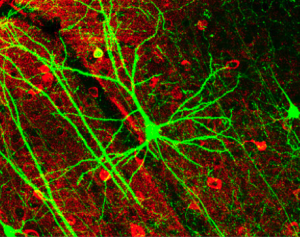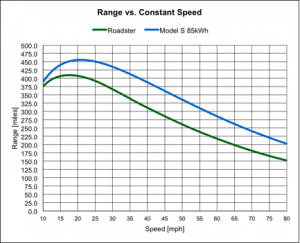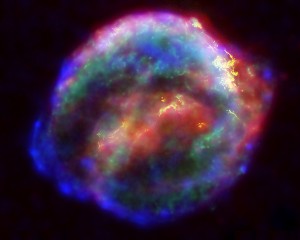Archive for the ‘Science News’ Category
Cleaning Oil Spills with Nanotube Sponges
Of all materials of the future, few have captured the imagination more than carbon nanotubes. Science fiction fans have seen nanotubes as the key to building the stuff of our dreams – from space elevators to cyborg-like synthetic muscles. At the same time, practical, everyday uses have been popping up all over the place, creating a list so long in needed its own Wikipedia page.
Well, add another one to the list: cleaning up oil spills. It turns out that, if you add boron into the mix, it creates elbows in the tubes. So, instead of the traditional one-dimensional alignment we’ve already been getting so much fun out of, the fibers get connected together into a three dimensional sponge. Having created a sponge, scientists logically put it to work doing what sponge-like structures do best – soaking stuff up. Made up of carbon, it attracts oil and repels water, and it can absorb up to 100 times its weight in oil according to Bobby Sumpter at the Oak Ridge National Laboratory.
Recording Information From the Brain
The workings of the brain have remained obscure throughout the development of neuroscience, with efforts to probe them often gruesomely coarse and attempts to change them . . . really even worse (from lobotomies to electroshock therapy, just to name the most well-known controversial techniques). That may all soon change.
So far, examining the brain at the cellular level (as opposed to simply checking which region of the brain is electrically active) has been a surprisingly manual task. While other areas of biology have benefited from robotics and automation, the brain was left to the highly trained hands of brain surgeons. After all, the area is sensitive and merits painstaking care – especially since any proper study of the brain requires it to be a living brain.
Do Black Holes Inhibit Star Formation?
It’s actually more of an open question than I would have thought. At face value, you would expect that the presence of a powerful black hole would disrupt the normal star formation processes, and the evidence is certainly leaning that way. However, there’s still enough uncertainty on the issue to keep some astronomers with the Herschel Space Observatory mission busy (and, I suppose, paid).
The results from Herschel show that in galaxies 8 to 12 billion light years away (and therefore 8 to 12 billion years ago), star formation slowed dramatically, and the deceleration was greater in galaxies with large central black holes. As would seem logical, the black holes ripped up the coalescing gas, keeping it from gathering into the necessary density. You can read more about it here.
The most striking fact presented by the article is the degree to which star formation has declined since that time. Eight to twelve billion years ago, stars were forming at ten times the rate that they are now, and galaxies were a thousand times brighter than they are now! It’s difficult to really grasp the magnitude of the fact. I mean, we all hear that the universe has cooled over its life, and will continue to get colder, but . . . we don’t often talk about how much darker it’s getting, do we?
I’m sure some astronomer will point out that, if you look at infrared wavelengths, it’s actually quite bright, but the point is that the infrared light was produced long ago. Our light bulbs are going out and a lot of the light is only there because it took this long to get to us. And the damned black holes have been making the matters worse!
Ahem. Anyway, it does make you wonder whether the fundamental constants of the universe were as perfectly tuned as they could have been, doesn’t it?
Tesla Model S Range
Yesterday, Elon Musk and JB Straubel blogged details about the Tesla Model S‘s range and efficiency. You can read their original article here, with details about the test conditions. Incidentally, Elon Musk is not only the CEO of Tesla Motors, but also the CEO and Chief Designer of SpaceX, so our future in space may well rest in his hands. It’s worth paying attention to what he’s up to.
This graph provided by Tesla Motors neatly summarizes the performance of the Model S and the improvement over the Roadster on the critical issue of range:
Solar Cell Efficiency Boosted by Wrinkles
While we normally associate wrinkles with aging, nature likes to add wrinkles to surfaces improve efficiency. The wrinkles of the brain increase surface area and therefore processing capability. The friction ridges on our fingertips allow for fine texture perception. Most importantly for the context of this article, nature produces wrinkles in leaves to improve the capture of energy from light.
Taking this cue, researchers from Princeton and the University of Pennsylvania decided to try the same with photovoltaics, which have so far been rather remarkably flat:
Quantum Dots and the Future of Lighting
Quantum dots are crystals in which the bound states of the electrons are confined in the three spatial dimensions. They have electronic properties between those of semiconductors and discrete molecules. Their characteristics are related to the size of the crystal, so the manufacturing process can precisely control them. My main interest in them lies in the future of computing – the possible development of quantum computers. However, along the way, researchers are trying to put them to use in all sorts of ways.
This time we have a seemingly mundane attempt to put them to use: in lighting. As anyone who can afford a good television/computer/handheld device knows, the cutting edge in lighting is now these guys:
LEDs (light-emitting diodes), which are semiconductor light sources. They are energy-efficient, long-lasting, and easy on the eyes. Actually, the use of energy is key to their long life – the less energy you use, the less heat you generate, and the less wear the light source will experience. Unfortunately, we can’t buy LED lights for room lighting yet (unless I’m behind the times, which is entirely possible), but already quantum dots are popping up as an alternative:
Two Type Ia Supernovae?
Type Ia supernovae are “standard candles” with which we measure the universe. We can use them for this purpose because they appear to have definite light curves – that is, their luminosity decreases with time at a predictable rate. Since time and distance are generally interchangeable when dealing with stellar phenomena (both are governed by the speed of light – if we see something happening one light year away, it’s happening one year in the past), we know that the dimmer a Type Ia supernova is, the further away it is, and we can get the particular distance.
Why do Type Ia supernovae have this quality when other supernovae don’t? It’s because of the way they’re formed. They start off as a binary star system with a stable white dwarf star at the center. Over time, the central star accumulates material from its companion star through gravity, and approaches the Chandrasekhar limit – the maximum size a white dwarf can reach without collapsing – which is around 1.4 times the mass of our Sun. Since the supernova occurs right when the white dwarf reaches this limit, the nature of the collapse is pretty close to exact. Here’s a diagram from NASA to illustrate some of the particulars:






